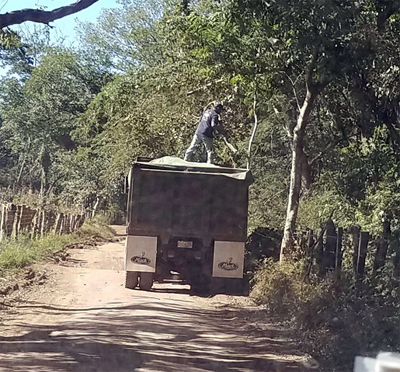Watson Says... |
 |
| ...Self driving trucks may actually create more jobs for drivers--as companies rely more on drivers to make the final delivery, help with sales, and gather competitive information. |
 |
What do you say? |
 |
| Click here to send us your comments |
|
|
|

The above picture is one I took while on vacation in Costa Rica. We were going to a remote beach at the end of a 3-mile pothole and rut-stricken dirt road. We happened to be following a truck making a delivery. The truck got stuck by an overhanging tree. The driver immediately got out, with a large machete in hand, hopped on the top of the truck and proceeded to cut away the offending branch. Within a few minutes, he was back on the road.
I was thinking that it was going to be a long time before self-driving trucks have built in machetes on the top. And, some people may even worry about such a feature. I have the feeling that this job on this route is safe for quite some time.
Most places trucks go don’t have a need for the driver to clear a path with his machete. So, what will the new role of drivers be when self-driving trucks start hitting the road?
In a previous post, we mentioned that self driving trucks may actually create more jobs for drivers-- as companies rely more on drivers to make the final delivery, help with sales, and gather competitive information.
Another new role we anticipate is the need for people to remotely monitor each of the trucks on the road. I picture a big war-room with 100s of monitors showing what is in front of each truck, what is behind it, and maybe what the load looks like. The controls will give the operator the ability to have two-way communication to talk to someone near the truck, the ability to provide new direction, and ability to see and respond to alerts or problems. This will be needed to prevent theft of cargo and to allow interactions at key points. For example, you may need to talk to someone at a re-fueling station, deal with an policeman who pulls over your truck, or even negotiating to find a spot to park the truck when the warehouse can’t unload it. A single person may be watching over ten to fifty of these trucks at time. This obviously won’t replace all the jobs of people in the trucks, but will replace some.
There may also be a bigger need for brokers to match empty trucks with with loads. Truck owners that keep the truck making productive moves 24x7 (with just stops for re-fueling and maintenance) will be much more profitable. To do this, you will need brokers to help find these productive moves. And, since the cost to the shipper will be lower, shippers are likely to want to move even more loads-- they won’t wait to fill up a truck. And, there are likely to be more opportunities for matching trucks to loads. For example, with drivers you have to worry about running out of time. But, if half full truck is passing by a load that would fill up the other half, it is much easier to pull over and get that load. You may add a few hours to the delivery time, but you don’t have to worry about having to rest for another 8-10 hours.
Final Thoughts
I’m optimistic about the future of self-driving trucks. I don’t think the 2 million truck driver jobs will just disappear. I think the nature of these jobs may change and it could be painful for the drivers who are directly impacted if they can’t move into new roles. But, I think self-driving trucks will open up a whole new set of opportunities.
Any reaction to this Expert Insight column? Send below.
Your Comments/Feedback
|